L’powdery mildew of the vine is a disease caused by a fungal pathogen, in particular an ascomycete fungus. It is considered one of the most problematic pathologies for this plant, as it is able to jeopardize the annual grape production. It has specific symptoms, even if not clearly visible in the initial stages. In addition, it affects in several parts, both in terms of the plant and the fruit. For these reasons, it is essential to know how to recognize it at the first signs, so as to be able to implement biological defense in the best possible way in time.
Agronomic prevention techniques are also important in combating this fungal disease, as they help to limit predisposing conditions to a minimum. Fortunately, there are also biological remedies to avoid damage to powdery mildew in viticulture; some classic, but still effective, others experimental and with good prospects for implementation.
In this article we see everything there is to know to defend our vineyard.
The powdery mildew of the vine
For an exact identification of the powdery mildew of the vine, it is necessary to distinguish the gamic form of the fungus Erysiphe necatorfrom the agamic one Oidium tuckeri. In fact, an ascomycete fungus produces fruiting bodies containing ascus with ascospores
in the gamic phase (or ascophor), while it forms the conidia in the agamic or conidiophora phase. Both of these fungal forms, agents of powdery mildew, can appear on the vine. In general, powdery mildew it is an obligate ectoparasite, meaning that it cannot survive without its specific plant host.
How it forms
The pathogen responsible for powdery mildew develops its mycelium outside the affected plant tissues, inside which it sends austori, formations that absorb the nutrients of the plant cell. The conidiophore branches are formed from the hyphae of the mycelium, which will later give rise to the chains of conidia responsible for the spread of powdery mildew on the rest of the plant.
The set of hyphae, conidiophores and conidia forms what is the macroscopic aspect that makes the powdery mildew visible to the naked eye, that is to say the typical white mold with a powdery consistency that covers the affected tissues.
Life cycle and conservation
The powdery mildew of the vine can be preserved during the winter in two ways. The first way is the fruiting body of its sexual phase: it is a characteristic globose cleistotecio, surrounded by a series of septate hyphae folded in the terminal part. The fruiting body is preserved on the fallen vegetation; The second way is through the mycelium: it is a wintering mycelium in the ravines of the buds or among the pearls. In this case, the spring attacks on the shoots can be very early.
Symptoms of powdery mildew on the vine plant
Symptoms on the leaves
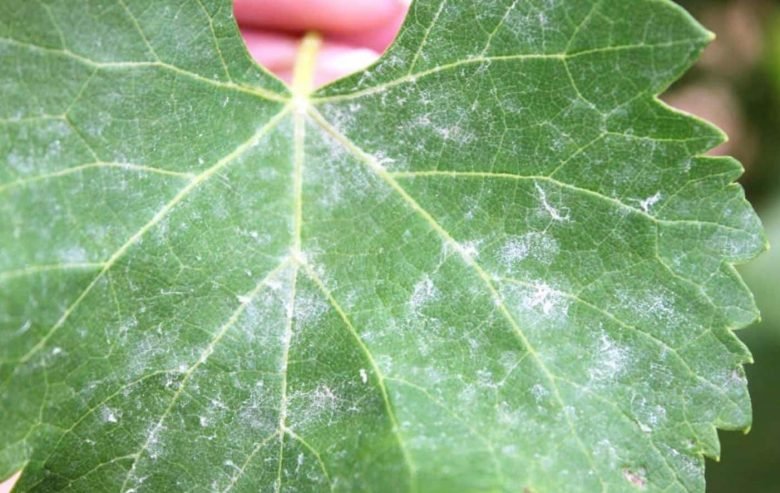
Powdery mildew is capable of affecting the vine in several places. Lighter areas are highlighted on the leaves, above which, at the beginning, an evanescent whitish patina appears, which evolves into a powdery efflorescence. As the disease progresses, and in the event of severe attacks, the leaf veins darken and necrotic speckles appear. In the very early stages, these symptoms are not too obvious, so you have to be very careful when observing the leaves. For example, you can observe the leaves against the light and check for translucent and discolored areas.
It is the underside of the leaf that is most affected, so careful observation should be concentrated in this position. As the infection progresses, there are also physical signs on the vine leaves. In particular, the folding of the leaf blade upwards, that is to say “cup”. Eventually, the leaves turn yellow and drop off prematurely.
Symptoms on the shoots
On the shoots of the vine the damage of the powdery mildew is more serious, although fortunately rarer. Furthermore, it is limited exclusively to vineyards located in areas with very mild winters. The symptom is due to the wintering mycelium, protected by the pearls inside the buds. In spring, with the vegetative restart, the newly opened infected shoots are precociously covered with abundant whitish and powdery mold. The development of the leaf is compromised at the start, and the shoot takes on a so-called “flag” appearance.
Symptoms on the shoots
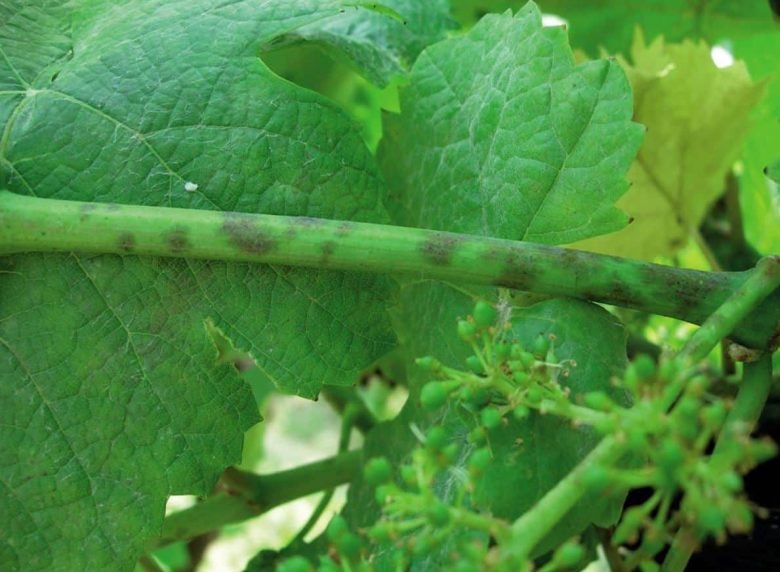
Powdery mildew is able to affect even the young shoots of the vine. As for the leaves, at the beginning the infection is not very visible, as it consists of a rather sparse mycelium with little sporulation. Subsequently, however, necrosis of the superficial cells occurs and brown areas with a reticulated appearance appear on the shoot, which remain visible even following the lignification of the shoot itself. The chances of shoot symptoms are more frequent in the case of an early severe attack on vegetation. In autumn, the conservation structures of the fungus can be observed on the affected shoots.
Symptoms on flowers and clusters
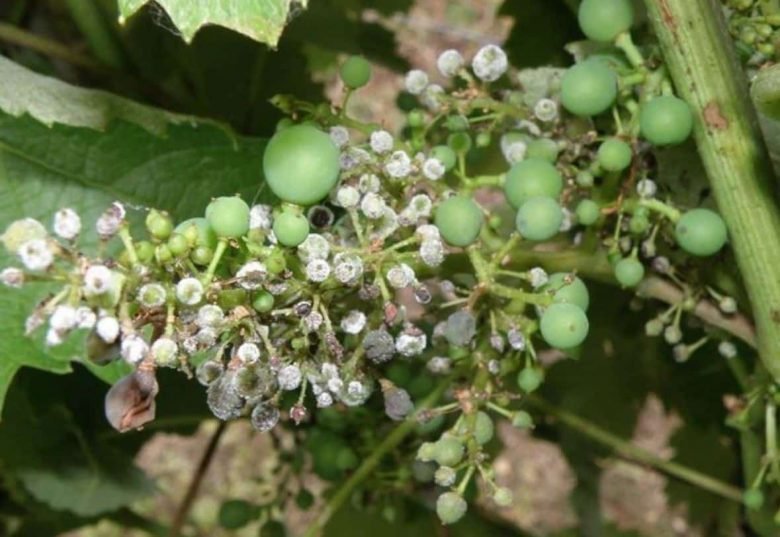
Another serious symptomatology is that on the inflorescences of the vine, as the powdery mildew can strike even before the actual flowering takes place, or before the flowers open. The attack of powdery mildew on the vine, in this case, causes the dripping of the flowers or the failure of the bunches to grow. On the cluster, the attack can take place in different phenological phases.
Post-flowering infection causes necrosis of the berry epidermis, which stops its growth and splits, opening the way for other infections (especially botrytis).
The attack can take place later, during the growth phase of the bunch, in which case punctuation, browning and the typical white powder of powdery mildew form on the berries. Bunches of grapes are generally very susceptible to this disease, even if the evolution is very slow. For example, an infection that starts in June may only be visible in August.
Extent of damage from the powdery mildew of the vine
As we have just seen, powdery mildew is able to affect all the vegetative parts of the vine. The extent of the damage depends on various factors, such as the time of infection, the inoculation of the pathogen, the affected area, etc. In general, powdery mildew, however serious the attack may be, hardly leads to the death of the vine plant. The damage is estimated mainly on the grape production of the year, which is seriously affected, as the pathogen always causes stunted vegetative development and compromises the normal activity of photosynthesis. When the powdery mildew of the vine attacks flowers and clusters, it is also easy to completely lose production.
As indirect damage, powdery mildew makes the vine more susceptible to other diseases, such as downy mildew or the botrytis.
Environment favorable to the oidium of the vine
Apart from early wintering mycelium infections, powdery mildew usually affects vineyards in summer, with an optimum temperature of 25-26 ° C. Furthermore, the atmospheric humidity is usually low, around 40-50%. Contrary to other fungal pathogens, frequent rains hinder the powdery mildew of the vine, as water inhibits the germination of conidia. For this reason, the hilly areas of the southern regions, subject to minor temperature changes and little summer precipitation, are more prone to powdery mildew. Lowland environments, with wetter summers, are less so. However, with climate change underway and which reserve continuous surprises, no area can be considered a priori unscathed.
Forms of farming and agronomic prevention
The good exposure of the grapes to the sun is a factor that protects the vine from powdery mildew, as direct sunlight inhibits the germination of powdery mildew conidia. The espalier training forms, such as the Guyot and the spurred cordon they are more adequate in this sense, unlike the pergola farmswhose intrinsic characteristic is precisely the lower exposure of the bunches to the sun.
L’summer pruning of the vinecalled flaking or spampinatura, increases the exposure of the bunches to the sun, therefore it is an excellent agronomic prevention technique of powdery mildew.
Another good prevention practice is to remove all infected vegetation residues at the end of the season. These they must then be burnedso as not to allow the preservation of the pathogen.
Biological defense against the powdery mildew of the vine
The product allowed in organic farming which historically is used against powdery mildew is sulfur, both pure, in powder form, and in wettable formulations. Being able to damage various aspects of the pathogen’s biology, it does not allow the onset of resistance phenomena.
How sulfur works
Sulfur penetrates the fungal cell, damaging the cell membrane of the fungus, from which water escapes. The death of the fungus responsible for powdery mildew occurs through dehydration.
In addition, it also has an anti-tritis function, so that two fungal diseases are prevented with a single curative treatment. However, its action is limited in time and the treatments must be repeated.
Furthermore, it can give problems to winemaking, as a significant presence of sulfur on the surface of the bunches determines the alteration of the fermentation processes, which can potentially alter the organoleptic qualities of the wine. For this reason, many recommend the use of sulfur, especially the powdery one, only in the phases of pre-flowering and preclosure of the bunch, severely limiting its use in other periods.
Alternatives to sulfur
To continue the defense against the oidium of the vine during the season, excellent results are being obtained with the use of potassium bicarbonate he was born in sodium bicarbonate, less aggressive products than sulfur, but equally valid. The action of bicarbonates is twofold, as they directly damage the cell membrane in the spores and, at the same time, raise the pH at the level of the leaf surface, creating an inhospitable environment for the proliferation of pathogen spores. Both bicarbonates have a preventive action, but pay attention to their correct use, especially in the case of sodium bicarbonate. Exaggerating the dosages, in fact, can cause even extensive leaf burns, with impairment of photosynthesis and raising of the soil pH.
The advice is to carry out the treatment only in the evening, at a dosage of 1% on the water, or 1 kg per 100 liters of water.

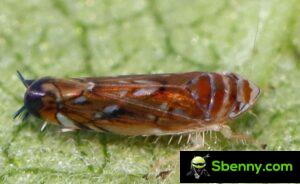
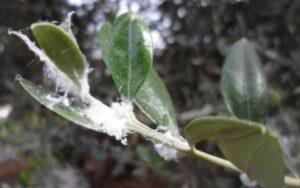
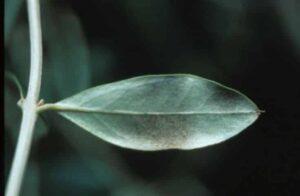
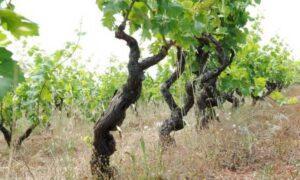
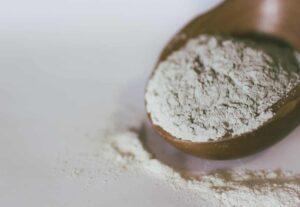
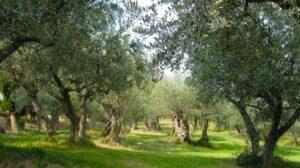
Start a new Thread